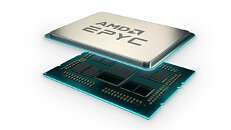Friday, May 14th 2021

AMD and GlobalFoundries Wafer Supply Agreement Now Non-Exclusive, Paves Way for 7nm sIOD
AMD in a filing with the U.S. Securities and Exchange Commission (SEC), revealed that its wafer supply agreement with GlobalFoundries has been amended. Under the new terms, AMD places orders for wafers from GlobalFoundries up to 2024, with purchase targets set for each year leading up to 2024. Beyond meeting these targets, AMD is free from all other exclusivity commitments. The agreement was previously amended in January 2019, setting annual purchase targets for 2019, 2020, and 2021, while beginning a de-coupling between AMD and GlobalFoundries. This enabled the company to source 7 nm (or smaller) chips, such as CCDs and GPUs, from other foundries, such as TSMC, while keeping GlobalFoundries exclusive for 12 nm (or larger) nodes.
The updated wafer supply agreement unlocks many possibilities for AMD. For starters, it can finally build a next-generation sIOD (server I/O die) on a more efficient node than GlobalFoundries 12LP, such as TSMC 7 nm. This transition to 7 nm will be needed as the next-gen "Genoa" EPYC processor could feature future I/O standards such as DDR5 memory and PCI-Express Gen 5, and the switching fabric for these could be too power-hungry on 12 nm. The "Zen 4" CPU core complex dies (CCDs) of "Genoa" are expected to be built on TSMC 5 nm.
Source:
Anandtech
The updated wafer supply agreement unlocks many possibilities for AMD. For starters, it can finally build a next-generation sIOD (server I/O die) on a more efficient node than GlobalFoundries 12LP, such as TSMC 7 nm. This transition to 7 nm will be needed as the next-gen "Genoa" EPYC processor could feature future I/O standards such as DDR5 memory and PCI-Express Gen 5, and the switching fabric for these could be too power-hungry on 12 nm. The "Zen 4" CPU core complex dies (CCDs) of "Genoa" are expected to be built on TSMC 5 nm.

17 Comments on AMD and GlobalFoundries Wafer Supply Agreement Now Non-Exclusive, Paves Way for 7nm sIOD
I would expect the IOD perform much better, moving to 7nm.
A lot of interesting info on this topic can be found in this anandtech review: Power & Efficiency: IOD Power Overhead? - AMD 3rd Gen EPYC Milan Review: A Peak vs Per Core Performance Balance (anandtech.com)
I know there's still a healthy market for their 12/14nm process but they can't just stick their head in the sand and ignore newer, faster, denser, more efficient nodes; That way lies a dead end and the end of GloFo.
It's a strategy can keep GF profitable in the long term, even it they always choose to follow rather than lead; but they must at least follow, not just stick their head in silica sand forever.
www.extremetech.com/computing/249075-foundry-futures-tsmc-samsung-globalfoundries-intel-gear-7nm-beyond
There are plenty of customers that dont need a cutting edge node, and GloFo is more then happy to fulfill those quotas. Doesnt do much for us enthusiasts but it's a huge help for other sectors that just need processors for various things.
Other than AMD/IBM, GlobalFoundries has a normal amount of zero customers on 14nm/12nm. No customers to support a push to 7nm, means no 7nm and lower nodes. AMD/IBM ditched GlobalFoundries when they would have had to give $3B to get 7LP to 12,000 wpm. Since, no else bothered thus it died and it will remain dead.
Now compare UMC to TSMC:
GlobalFoundries canning 7nm makes sense. GlobalFoundries doing whatever happened to 12FDX, makes none. Unlike, the FinFET nodes, it actually had reserved customers in 2017.
community.cadence.com/cadence_blogs_8/b/breakfast-bytes/posts/dream-chip-cnn-for-your-car
"Migrate to 12FDX (12nm)"
Dream Chips then and now Goodix: Veyron to Chiron
There is also a case that the Rockchip 3588 potentially was going to be on 12FDX as well.
Basically, anything with 8LPP could have been 12FDX instead. Especially, if there was a 22nm node that is synonymous with 22FDX.
www.samsungfoundry.com/foundry/homepage/anonymous/technology12inch.do?_mainLayOut=homepageLayout&menuIndex=0201
I wonder what the delay is this time? GloFo were there with 14nm at the beginning when AMD, Apple, & Nvidia finally moved off TSMC 28nm. If they're licensing from Samsung, why give up the unstoppably profitable chance to license Samsung 8nm? TSMC has been raking in ungodly amounts of money since 7FF and I figured GloFo would love to compete with that, even if it's only a licensed process and not 100% their own.
As of the last 15 months, anything made on 7nm or 8nm will sell for top dollar, no matter what.